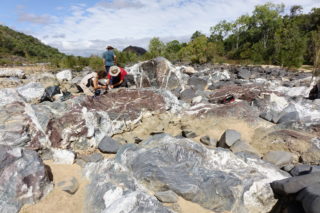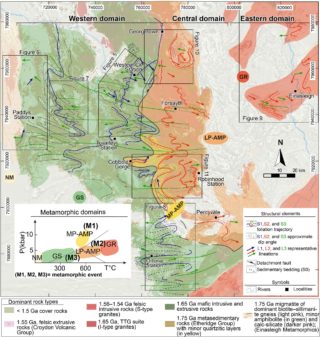Structural and metamorphic evolution of the final Nuna assembly in northeast Australia
Researchers from the Earth Dynamics Research Group have shown in previous work that 1.7 billion year old rocks from the Georgetown Inlier (in North East Australia) bear a striking resemblance to those found in modern-day Canada (previously known as Laurentia). That finding provided compelling evidence for the suggestion that the Georgetown continental block broke off from Canada and collided with northern Australia (Mount Isa region) around 1.6 billion years ago during the assembly of the Supercontinent Nuna, also known as Columbia. To further investigate this collision it was necessary to study other rocks from the surrounding areas to unlock the structural and metamorphic evidence associated with this 1.6-billion-year collisional event in the Georgetown region of Laurentian origin.


In three recent contributions (Volante et al., 2020a, 2020b, & 2020c, listed below) Ms Silvia Volante and colleagues combined field-based regional geology, with structural mapping, mineral geochemistry, thermodynamic modelling and geochronology to better understand the processes and architecture of this orogenic belt. The work is not only multi-disciplinary in approach but also spans many magnitudes of scale, from the regional (10-100 km) scale all the way down to the elemental (μm) scale.
Structural mapping of the Georgetown area allowed for the identification of superposed complex fabrics and their defining metamorphic mineral assemblages which are used to reconstruct the pressure and temperature conditions at which that specific volume of rock (i.e. sample) was deformed. Furthermore, by integrating different isotopic systems, such as Lu–Hf and U–Pb in garnet and monazite, respectively, it is possible to characterise the age (i.e. time) of minerals that grew during successive deformation events that deformed the Australian and Laurentian rocks during the collision of the two continents.

The metamorphic and structural results point to the presence of two major tectono-metamorphic events in the Georgetown province: a c. 1.6 billion-year syn-collisional medium-pressure and medium-temperature metamorphism (M1), and a c. 1.55 billion-year post-collisional low-pressure and high-temperature event (M2). These two metamorphic events are heterogeneously recorded within three identified tectono–metamorphic domains: the western, central and eastern domains, which represent upper (0-3 kbar), middle (4-6 kbar) and lower crustal (6-9 kbar) sections, respectively in the Georgetown Inlier. The 1.6 billion-year collision is well-recorded in the western, low-grade domain, where the original orientation of 1.6 billion-year structures reflect a major E-W bulk-shortening direction (D1). These early structures were obliterated eastward by the higher-grade 1.55 billion-year deformation event (D2). The latter is extensively recorded in the central and eastern domain and is associated with the development of N-S oriented extensional structures, contemporaneous to the generation of abundant segregation of melt and low temperature hydrous granitic magmatism in the eastern and central domains, respectively (Volante et al., 2020c). D2 structures coincide with a crustal-scale, extensional detatchment zone, represented by the central and eastern domains. During this stage of the orogenic belt, middle and lower crustal levels were partially exhumed. The last deformation event identified in this area occurred post-1.55 billion-year and it was related to N-S shortening (D3) which developed the present-day structural frame of the Georgetown province.

This study shows that the structural and thermal architecture of the c. 1.6 billion-year orogenic belt in NE Australia is characterised by a combination of distinct tectonic and metamorphic stages and it supports the continental collision between the Laurentian and Australian blocks during the final assembly of the Supercontinent Nuna.
Contact person: Ms Silvia Volante & Prof Zheng-Xiang Li, Earth Dynamics Research Group, Curtin University. Silvia is now at – Institute of Geology, Mineralogy and Geophysics, Ruhr‐Universität Bochum, Bochum, Germany.
Relevant publications:
Volante, S., Pourteau, A., Collins, W.J., Blereau, E., Li, Z.-X., Smit, M., Evans, N.J., Nordsvan, A.R., Spencer, C.J., McDonald, B.J., Li, J., Günter, C., 2020a. Multiple P–T–d–t paths reveal the evolution of the final Nuna assembly in northeast Australia. Journal of Metamorphic Geology, 38(6), 593-627. https://doi.org/10.1111/jmg.12532
Volante, S., Collins, W.J., Pourteau, A., Li, Z.-X., Li, J., Nordsvan, A.R., 2020b. Structural Evolution of a 1.6 Ga Orogeny Related to the Final Assembly of the Supercontinent Nuna: Coupling of Episodic and Progressive Deformation. Tectonics, 39(10), e2020TC006162. https://doi.org/10.1029/2020TC006162
Volante, S., Collins, W.J., Blereau, E., Pourteau, A., Spencer, C., Evans, N.J., Barrote, V., Nordsvan, A.R., Li, Z.-X., Li, J., 2020c. Reassessing zircon-monazite thermometry with thermodynamic modelling: insights from the Georgetown igneous complex, NE Australia. Contributions to Mineralogy and Petrology, 175, 110. https://doi.org/10.1007/s00410-020-01752-7
